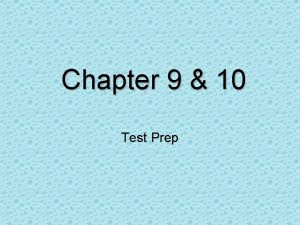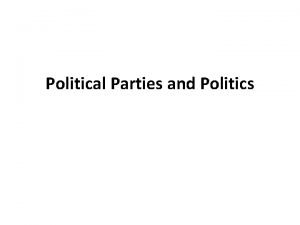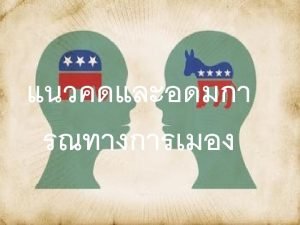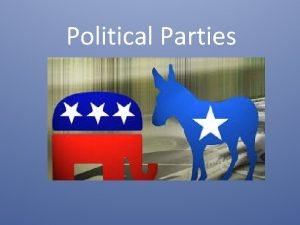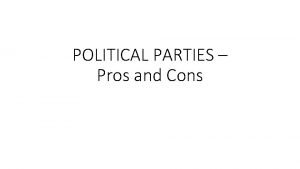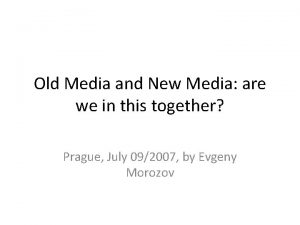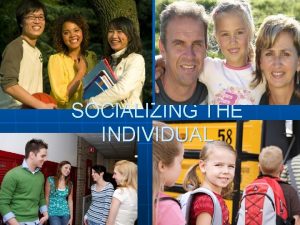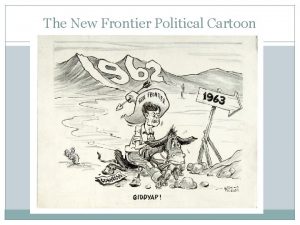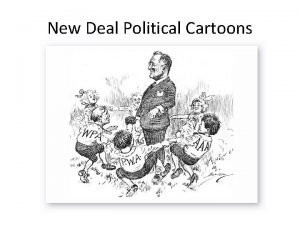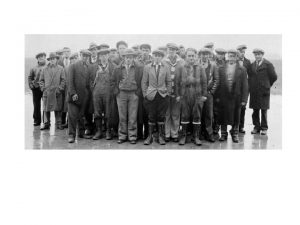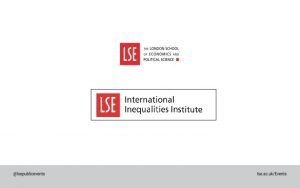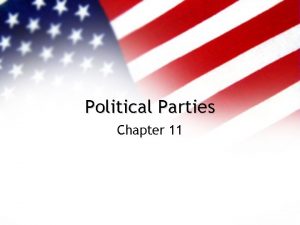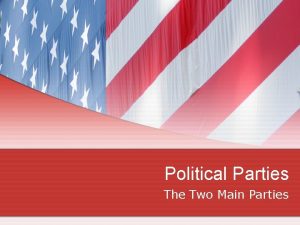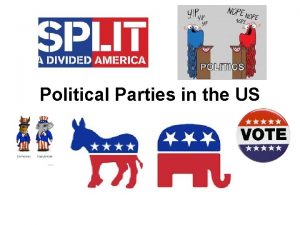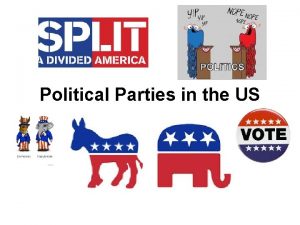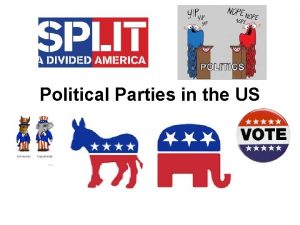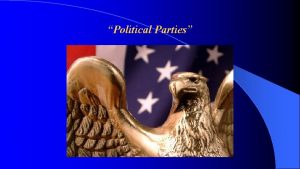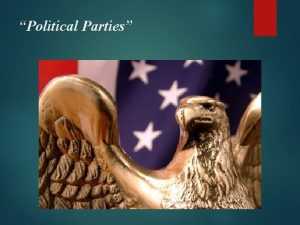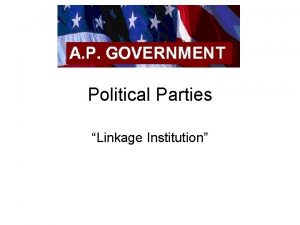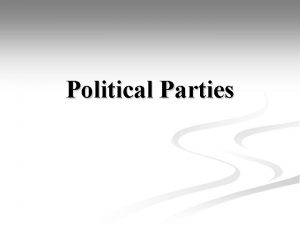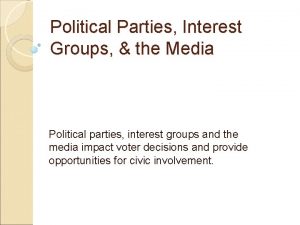Political Parties Use of New Media Professor Rachel















- Slides: 15

‘Political Parties Use of New Media’ Professor Rachel Gibson, Institute for Social Change, University of Manchester. Workshop 1 B ‘The role of political parties in electoral processes’ Council of Europe Forum for the Future of Democracy October 21 -23, Kyiv, Ukraine

Overview of presentation n n Identify the key areas of change for parties in the electoral sphere as a result of adaptation to the new media age. Focus on 3 key domains: Campaign communication & management ¨ Party Competition ¨ Effects on the electorate ¨

New media and party campaign communication. n Parties, political communication, wider elections literature all identified growing importance of campaigning – identified move toward more professionalised and high-tech style emerging in last 2 decades of 20 th century. n Labelled as ‘Americanised’, ‘Modernised’ ‘Political Marketing’ ‘Capital-intensive’ (Butler and Ranney, 1992; Swanson and Mancini, 1996; Newman, 1999; Plasser, 2000, Farrell and Webb, 2000) n Characterised by reliance specialist media/PR consultants, opinion and opposition research, database development, direct mail, telemarketing. Key shift in campaign communication style was move from ‘one size fits all’ televisual era to niched, targeted and personalised communication.

n n n New media fits well with these changes – promotes more niched/narrow-casted approach to voter communication. Email, SMS, mobile telephones all promote this more niched and individualised approach. Now with the rise of web 2. 0 technologies – blogs, SNS, video sharing channels the possibilities for personalised communication have expanded greatly. Of course the challenge parties face is how to distribute their message across these personalised and ‘private’ networks. While bringing more personalised direct commmunication style back does it narrow the message too much? Is a ‘broadcasting’ approach more inclusive?

New media and campaign management n n n As well as changing the style of voter communication new media also offer potential for even greater change in how parties manage and run election campaign. The interactivity and participatory elements bring radically new ways to open up and involve ‘amateurs’ or ordinary supporters. Again, Web 2. 0 developments open up great possibilities for a more participatory and grass-roots led campaign (e. g. ’s from U. S. 2008 growth of ‘citizen-campaigning’ phenomenon). How far does it travel outside U. S. Little evidence taking hold elsewhere. Studies of parties’ online campaign communication since 1996 worldwide rejected the idea that seeking to promote dialogue with voters (Davis et al. , 2008). Why different in the U. S. ? Party system a factor Further question to raise is what are downsides to this? Loss of control of message? Multiple, possibly competing campaign groups and fragmentation of platform.


New ICTs and party competition: rebalancing the system? n Can the new media democratise the party system and electoral process by boosting the profile and voice of smaller parties/independents, challenging the dominance of the major players in the mainstream media? n To date the evidence from studies of party systems around the world has suggested that aside from a few high profile anomalies (Ventura, Dean, Roh Moo-Hyun), generally across party systems, the major players have continued to have a wider and better quality presence online (Gibson et al. , 2003; Strandberg, 2006; Farmer and Fender, 2005; Norris, 2001)

However… Certain smaller players do ‘punch above their weight’. Green parties generally seen to do well. ¨ Even if new ICTs don’t equalise the communications playing field they widen it, allowing actors who would previously have lacked organisational resources the opportunity to mobilise and recruit support. ¨ There is a possible ‘force multiplier’ effect that the web promotes through hyperlinks that can promote the presence of extremist groups in particular (Gerstenfeld et al. 2003). ¨

New media and parties’ ability to mobilise the electorate. n n n $64 million question… Does it work? Can parties actually generate votes via e-campaigning? Evidence so far has been limited and mixed but is increasing and pointing toward positive effects. First studies done in U. S. - D’Alessio (1997) a significant impact on candidate vote share, Bimber and Davis (2003) in 2000 rejected this. Fit with the normalisation thesis developing at the time. Overall work on general online usage and participation has indicated an increasingly positive relationship (Boulianne, 2009) and much publicised success of Dean and Obama in mobilising support via new ICTs increased claims for the effectiveness of online campaigns in generating support. Recently more focused studies outside of U. S. Ireland Australia (Suddulich and Wall, 2010; Gibson and Mc. Allister 2006, 2008) have revealed strong support for internet campaign effects. Conversion vs. Mobilisation? – it is the latter that matters most. (Brady et al. , 2009)

Conclusions: How has the new media affected parties in the electoral arena? n n n Overall the new media open up a series of opportunities and challenges to political parties in the electoral process. Rise of web 2. 0 in particular has increased opportunities for them to target voters, to ‘talk’ to voters and involve them in the campaign and recruit support. However they also present a challenge in that in chasing these benefits parties may lose their wide aggregating role, foster a more pluralised fragmented and ultimately incoherent message that cannot provide a governing mandate. Context clearly affects the extent to which these opportunities and challenges exist: internet access, party system, civic culture, election regulations all important. Time is ripe for future comparative work in the area!

Watch this space… n n n New 3 year project ‘The Internet, Electoral Politics and Citizen Participation in Global Perspective’ Comparative study of 4 elections - UK (2010) Australia (2010) France (2012) U. S. (2012) Parliamentary and Presidential systems – testing the idea of whether new style of bottom-up ‘citizen-campaigning’ taking hold and what its consequences are for parties, voters and wider democratic system.

Key question that emerges is how are the effects taking place? 2. Direct effects? Voters exposed to web campaign and decided to support the candidate. 3. Reverse Causation? Website establishment is the product of likely success. Frontrunners feel a greater pressure to establish a site. 4. Web as Proxy? Website captures good campaign management skills, organisation that controls in model not capturing? 5. Indirect effects? Two-step media effect? Those with a website generated more offline/mainstream media attention to the candidate which increased profile and levels of support Web signals candidate competence? Development of a content rich, personalised site provides a short-cut to voters of high quality candidate, boosts image and support.

Evidence on the question of how ecampaigns affects vote choice. n n n So far direct effects are largely dismissed due to small audiences for the campaign sites. Typically less than 5% of population accessing campaign sites and effects are over 2% increase in votes. Means ‘conversion’ rate or power of direct effects need to be v strong. Recent work by Gibson and Mc. Allister (2008) on Australian 2007 federal election sought to unpack this question – ran analysis across candidates from different parties up and also across different media technologies. Identified 3 types of web campaign operated: Web 1. 0, Web 2. 0 and personalised sites Green voters were influenced by web 2. 0 usage and Green candidates using web 2. 0 technologies gained more votes ¨ Supporters of major parties were not influenced by any type of web usage but major left-wing candidates using personalised websites gained more votes. However those using web 1. 0 technologies lost votes ¨ Major right-wing candidates did not benefit or lose from online campaign. ¨ n Concluded that use of web 2. 0 technologies might be directly mobilising support for Green candidates, but that web campaigning on personalised sites by major party candidates exerting more indirect effect, communicated more diffuse sense of candidate competence.

Web 1. 0

 Win the white house brainpop
Win the white house brainpop What was one way progressives differed from populists
What was one way progressives differed from populists Political parties
Political parties Political parties
Political parties Political party
Political party Sistemas democraticos
Sistemas democraticos Political parties
Political parties Political parties pros and cons
Political parties pros and cons Promotion from assistant to associate professor
Promotion from assistant to associate professor New media vs old media
New media vs old media Mattie is a new sociology professor
Mattie is a new sociology professor New frontier political cartoon
New frontier political cartoon New deal political cartoon
New deal political cartoon Dust bowl migration map
Dust bowl migration map Political lists new
Political lists new Political wish new
Political wish new

